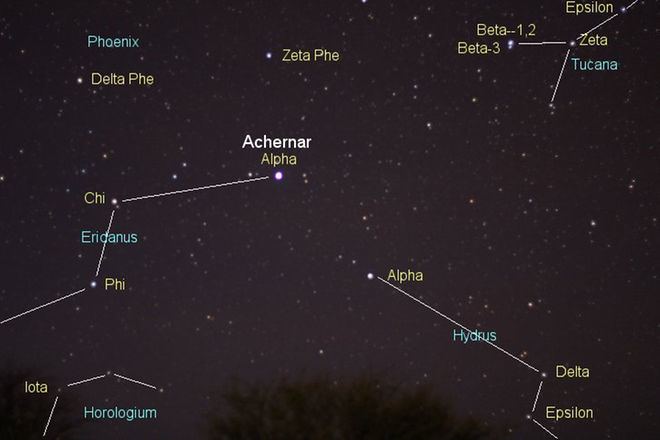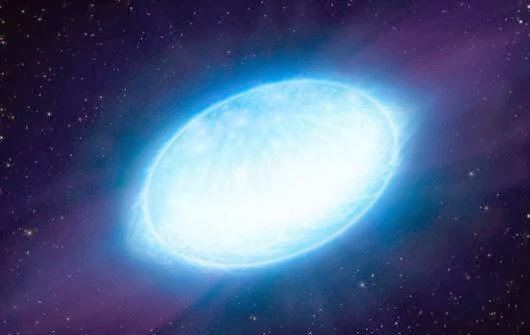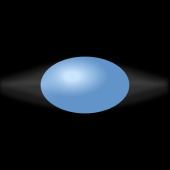Magnitude 0.445 Mass 1.333 × 10^31 kg (6.7 M☉) Apparent magnitude (V) 0.445 | Surface temperature 15,000 K | |
 | ||
Radius 7.934 million km (11.4 R☉) Similar Canopus, Capella, Beta Centauri, Alpha Crucis, Rigel | ||
Achernar /ˈeɪkərnɑːr/ is the name of the brightest component (by visual brightness) of the binary system designated Alpha Eridani (α Eridani, abbreviated Alpha Eri, α Eri), which is the brightest 'star' or point of light in, and lying at the southern tip of, the constellation of Eridanus, and the tenth-brightest in the night sky. The two components are designated Alpha Eridani A and Alpha Eridani B (known informally as Achernar B). As determined by the Hipparcos astrometry satellite, it is approximately 139 light-years (43 pc) from the Sun.
Contents
- Aurora in achernar a binary star system
- Nomenclature
- Namesake
- Properties
- Historical visibility
- References

Of the ten apparent brightest stars in the night-time sky, Alpha Eridani is the hottest and bluest in color, due to Achernar being of spectral type B. Achernar has an unusually rapid rotational velocity, causing it to become oblate in shape. The secondary is smaller, of spectral type A, and orbits Achernar at a distance of roughly 12 astronomical units (AU).

Aurora in achernar a binary star system
Nomenclature

α Eridani (Latinised to Alpha Eridani) is the system's Bayer designation. The designations of the two components - Alpha Eridani A and B - derive from the convention used by the Washington Multiplicity Catalog (WMC) for multiple star systems, and adopted by the International Astronomical Union (IAU).

The system bears the traditional name of Achernar, derived from the Arabic آخر النهر ākhir an-nahr, meaning "The End of the River". However, it seems that this name originally referred to Theta Eridani instead, which latterly was known by the similar traditional name Acamar, with the same etymology. In 2016, the IAU organized a Working Group on Star Names (WGSN) to catalog and standardize proper names for stars. The WGSN states that in the case of multiple stars the name should be understood to be attributed to the brightest component by visual brightness. The WGSN approved the name Achernar for Alpha Eridani A on 30 June 2016 and it is now so entered in the IAU Catalog of Star Names.

In Chinese, 水委 (Shuǐ Wěi), meaning Crooked Running Water, refers to an asterism consisting of Alpha Eridani, Zeta Phoenicis and Eta Phoenicis.
The indigenous Boorong people of northwestern Victoria named it as Yerrerdetkurrk.
Namesake
USS Achernar (AKA-53) was a United States Navy attack cargo ship.
Properties

Achernar is in the deep southern sky and never rises above the horizon beyond 33°N, roughly the latitude of Dallas, Texas. It is best seen from the southern hemisphere in November; it is circumpolar above (i.e. south of) 33°S, roughly the latitude of Santiago. On this latitude, e.g. the south coast of South Africa (Cape Town to Port Elizabeth) when in lower culmination it is barely visible to the naked eye as it is only 1 degree above the horizon, but still circumpolar. Further south, it is well visible at all times during night.

Achernar is a bright, blue star with about seven times the mass of the Sun. It is a main sequence star with a stellar classification of B6 Vep, but is about 3,150 times more luminous than the Sun. Infrared observations of the star using an adaptive optics system on the Very Large Telescope show that it has a companion star in a close orbit. This appears to be an A-type star in the stellar classification range A0V–A3V, which suggests a stellar mass of about double that of the Sun. The separation of the two stars is roughly 12.3 AU and their orbital period is at least 14–15 years.

As of 2003, Achernar is the least spherical star in the Milky Way studied to date. It spins so rapidly that it has assumed the shape of an oblate spheroid with an equatorial diameter 56% greater than its polar diameter. The polar axis is inclined about 65° to the line of sight from the Earth. Since it is actually a binary star, its highly distorted shape may cause non-negligible departures of the companion's orbital trajectory with respect to a Keplerian ellipse. A similar situation occurs for the star Regulus.
Because of the distorted shape of this star, there is a significant temperature variation by latitude. At the pole, the temperature may be above 20,000 K, while the equator is at or below 10,000 K. The average temperature of the star is about 15,000 K. The high polar temperatures are generating a fast polar wind that is ejecting matter from the star, creating a polar envelope of hot gas and plasma. The entire star is surrounded by an extended envelope that can be detected by its excess infrared emission, or by its polarization. The presence of a circumstellar disk of ionized gas is a common feature of Be stars such as this. The disk is not stable and periodically decretes back into the star. The maximum polarization for Achernar's disk was observed in September 2014, and it is now decreasing.
Historical visibility
Due to precession, Achernar lay much further south in ancient times than at present, being 7.5 degrees of the south pole around 3400 BCE (decl 82º40') and still lying at declination -76 by around 1500 BCE. Hence the Ancient Egyptians could not have known it. Even in 100 CE its declination was around -67, meaning Ptolemy could not possibly have seen it from Alexandria - whereas Theta Eridani was visible as far north as Crete. So Ptolemy's "end of the river" was certainly Theta Eridani. Alpha Eridani was not visible from Alexandria until about 1600 CE.
Until about March 2000, Achernar and Fomalhaut were the two first-magnitude stars furthest in angular distance from any other first-magnitude star in the celestial sphere. Antares, in the constellation of Scorpius, is now the most isolated first-magnitude star, although Antares is located in a constellation with many bright second-magnitude stars, whereas the stars surrounding Alpha Eridani and Fomalhaut are considerably fainter.
The first star catalogue to contain Achernar accompanied the chart of Eridanus in Johann Bayer's Uranometria. Bayer did not observe it himself, and is attributed to Keyser and the voyages of the Dutch. Thus, it was the last first magnitude star observed and the only one unknown to the ancient Greeks.
Alpha Eridani will continue to move north in the next few millennia, rising from Crete about 500 years hence before reaching its maximum northern declination between the 8th and 11th millennia, when it will be visible as far north as Germany and southern England.
